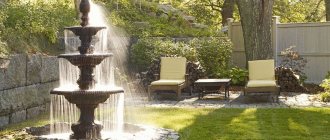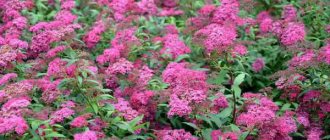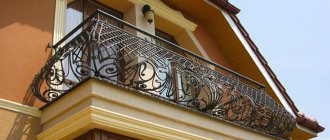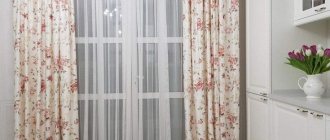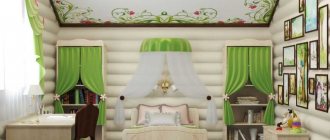Spiraea is a deciduous ornamental shrub of the Rosaceae family. Distribution area: steppes, forest-steppes, semi-deserts, mountain slopes, valleys. Landscape designers select varieties so that they bloom from early spring to late autumn. They place bushes singly and in groups, on garden paths, along fences, walls, and create borders, flower beds, rockeries, rock gardens.
Description of spirea
Spiraea (meadowsweet) - translated from ancient Greek means “bend”, has dwarf species up to 15 cm and tall ones up to 2.5 m. Its branches are erect, creeping, sometimes spread out, recumbent. Color – light chestnut, dark. The bark peels off longitudinally.
Leaf blades sit alternately on petioles, 3-5 lobed, oblong or rounded.
Inflorescences are paniculate, spike-shaped, pyramidal, corymbose. Located throughout the stem, in the upper part - at the ends of the branches. The palette of flowers is snow-white, cream, crimson, pink.
The root system is represented by adventitious roots and is shallow.
Reasons for the popularity of spirea in landscape design
Today, spirea in landscape design is one of the most popular plants. Benefits of growing shrubs in the garden:
- Great for decorating any style of landscape.
- There are tall (over 2.5 meters) and miniature (15-25 cm) varieties of the plant.
- Suitable for creating “live” hedges, borders, garden compositions, as a tapeworm, etc.
- Blooms beautifully and luxuriantly.
- The plant is represented by varieties that bloom in spring or summer - this is an ideal option for an “ever-blooming” garden.
- Very unpretentious, it is practically not affected by pests.
- This is an excellent honey plant.
In nature, this plant lives in steppes, deserts, and semi-deserts. Shrubs vary in appearance - they are spherical, pyramidal, creeping, erect and others.
Spirea - many advantages and almost complete absence of disadvantages
Spiraea: Japanese, gray, vangutta and other types and varieties
There are about a hundred species of spirea, they are divided into spring-flowering - they bloom in early spring on the shoots of the previous season in the second year after planting, the color is mostly white. They are also distinguished by the formation of many aboveground branches.
Summer-flowering ones form inflorescences at the ends of young shoots, while last year's ones gradually dry out.
Spring-flowering
When spring spireas bloom, they cover the leaves and branches with flowers.
| View | Description | Leaves | Flowers |
| Wangutta | Bushy, spreading, spherical up to 2 m, with drooping shoots. | Smooth, small, jagged, dark green, gray underneath, turning yellow in autumn. | White, honey-bearing, blooming from umbrella inflorescences. |
| Varieties | Bloom | ||
| Pink Ice. | May, August. | ||
| oak leaf | Frost-resistant shrub up to 1.5 m, branches pubescent. The crown is lush, rounded, and reproduces by roots. | Oblong, with teeth, dark green. The bottom is gray and yellow in autumn, up to 4.5 cm long. | Small, white, 20 pcs. in inflorescence. |
| Nippon | A low bush in the shape of a ball up to 1 m, the branches are brown, horizontal. | Round, bright green up to 4.5 cm, do not change color until mid-autumn. | The buds are purple and bloom white with a yellow-green tint. |
| Varieties | Bloom | ||
| May June. | ||
| Gorodchataya | Up to a meter high, the crown is loose. Tolerates low temperatures, drought, partial shade. | Gray-green, obovate with veins. | White, cream-colored flowers are collected in corymbose inflorescences. |
| Gray | Fast growing up to 2 m, with branched curved branches. Shoots are tomentose, pubescent. | Gray-green, pointed. | White, terry. |
| Varieties | Bloom | ||
| Grefsteim. | May. | ||
| Arguta | Spreading up to 2 m, branches thin, curved. | Dark green, narrow, jagged, up to 4 cm long. | Snow-white, fragrant. |
| Thunberg | Reaches 1.5 m, dense branches, openwork crown. | Thin, narrow. Green in summer, yellow in spring and orange in autumn. | Lush, white. |
| Varieties | Bloom | ||
| Fujino Pink. | Mid-May. | ||
Summer flowering
Summer ones form paniculate or cone-shaped inflorescences.
| View | Description | Leaves | Flowers |
| Japanese | Slow-growing, up to 50 cm, with erect, free stems, young shoots are pubescent. | Elongated, ovoid, veined, serrated. Green, gray underneath. | White, pink, red, formed at the tops of shoots. |
| Varieties | Bloom | ||
| June-July or July-August. | ||
| Willow | Up to 1.5-2 m, vertical, smooth branches. Juveniles are yellow and light green, turning reddish-brown with age. | Pointed up to 10 cm, jagged along the edges. | White, pink. |
| Douglas | Grows up to 2 m. Red-brown, erect, pubescent shoots. | Silvery-green, lanceolate with dark veins. | Dark pink. |
| Boumalda | Up to 75 cm, erect branches, spherical crown. | Obovate, green in the shade, in the sun: golden, copper, orange. | Pink, raspberry. |
| Varieties | Bloom | ||
| June August. | ||
| Billard | Up to 2 m high, frost-resistant. | Wide, lanceolate. | Hot pink. |
| Varieties | Bloom | ||
| Triumph. | July-October. | ||
| White-flowered | Dwarf, 60 cm - 1.5 m. | Large, green with a red tint, yellow in autumn. | Fluffy, white. |
| Varieties | Bloom | ||
| Macrophila. | July August. | ||
| Birch-leaved | Bush up to a meter, spherical crown. | Ellipse-shaped, light green up to 5 cm, turning yellow in autumn. | They bloom white with pink hues from 3-4 years of age. |
Plant selection criteria
All varieties of spirea are beautiful and picturesque all year round, regardless of whether the plant blooms or not.
When choosing a plant type for a summer cottage, they rely on the following criteria:
- Crown shape. Formed by a graceful interweaving of branches. Bushes with lush crowns are best used as single plants. Planted in a composition, they will interfere with the growth of other plants.
- Flowering time. Plants that bloom earlier bloom for a short time, while late bloomers delight with flowers until mid-autumn. Experienced gardeners, when composing compositions, skillfully combine different types of shrubs. This ensures continuous flowering of spirea during a warm period of time.
- Deciduous cover. Many varieties of spirea have original leaves of unusual colors. Foliage color can change many times depending on the season.
Features of planting spirea
Rainy and cloudy September weather is the optimal time for planting spirea. For cultivation, select an area with breathable, loose soil containing humus.
It is advisable to choose a place with access to the sun. Soil composition: leaf or turf soil, sand, peat (2:1:1). The planting hole is dug 2/3 larger than the seedling ball and left for two days. Place drainage on the bottom, for example from broken bricks. The roots are treated with Heteroauxin. Place the plant at 0.5 m. The root collar is left at soil level.
Planting in spring
In spring, it is possible to plant only summer-flowering plants before the leaves bloom. Select specimens that are flexible and have good buds. Dried roots are soaked in water, and overgrown roots are shortened. They lower the seedling, straighten the root, cover it with earth, and compact it. Water using 10-20 liters of water. A 7 cm layer of peat is placed around it.
Planting in autumn
In the autumn, summer and spring species of spirea are planted before the leaves fall. Pour soil into the center of the planting hole, forming a mound. The seedling is placed, the roots are leveled, covered and watered.
Spirea care
Caring for the shrubs is not difficult; water them regularly, using 1.5 buckets for each, 2 times a month. They loosen the ground and remove weeds.
They are fed with nitrogen and mineral mixtures in the spring, with minerals in June and with phosphorus-potassium in mid-August.
Spiraea is disease resistant. Spider mites may appear among pests in dry weather. The leaves have white spots on top, turn yellow and dry out. Treatment is carried out with acaricides (Acrex, Dinobuton).
Bitten off inflorescences indicate an aphid invasion; an infusion of garlic or Pirimor helps.
Insects: Variegated leaf miner and rose leaf miner cause leaves to curl and dry out. They use Etafos, Actellik.
To prevent the appearance of snails, treat spirea with Fitosporin and Fitoverm until the leaves appear.
Diseases and pests
The genus Spiraea is rarely affected by disease or pest attacks. Danger may include aphids, spider mites and leaf rollers.
- Signs of spider mites are the presence of thin webs and premature drying of leaves. Most often this happens during dry summers.
- Aphids damage the inflorescences of the plant, thereby reducing the quality of flowering.
- Leaves rolled into a tube and gnawed are signs of a leaf roller. It appears in May-June and can greatly spoil the appearance of the bush.
The fight against harmful insects is carried out using insecticides.
Sometimes shrubs are affected by various kinds of leaf spots - this group of diseases is caused by parasitic fungi. Control methods include removing the affected parts of the plant and treating the bushes with fungicides.
Mr. Summer Resident advises: pruning spirea
Without timely pruning, spirea looks unkempt; dry and weak branches prevent the formation of new shoots. To give the bush a decorative appearance, it is regularly pruned. Thanks to this, the plant forms powerful shoots and many inflorescences, allows more light and air to pass through, and reduces the risk of attack by pests and diseases.
In early spring, before the buds open, sanitary pruning is carried out. Frozen, diseased, thin, broken, dried branches are cut out from spirea. After flowering ends, spring varieties are immediately pruned and dry inflorescences are removed. New shoots with bright green leaves are removed from Japanese spirea.
For early bloomers, older than 3-4 years, stimulating pruning is carried out and in the fall they are cut to a quarter of the length. The plant can be given any shape desired (ball, square, triangle).
It is recommended to feed with mineral mixtures after the procedure.
Summer flowering plants need stimulating pruning from 3-4 years of age. Remove weak, diseased, old branches to the neck level with sharp pruning shears in the fall, half a month before frost, leaving 2-3 buds.
For spirea older than 7 years, anti-aging pruning is also carried out 2-3 weeks before frost. All branches are cut to the soil level, leaving 30 cm. In spring, the bush forms young shoots.
Reproduction of spirea
To propagate by seeds, they are sown in prepared containers with wet sand and peat and sprinkled. They emerge after 1.5 weeks, are treated with Fundazol, and after 2-3 months they are transplanted into a specially designated bed in partial shade, while shortening the roots. Water generously. Flowering is expected only for 3-4 years.
Layering is a more common method of propagation. In the spring, before the leaves appear, the lower shoots are bent to the ground, fixed with a rod, wire, and sprinkled. Water regularly.
Replant the next year after the root system is fully formed.
In autumn, cuttings cut at an oblique angle of 15-20 cm are soaked for 12 hours in Epin, then treated with Kornevin and rooted in damp sand. After 3 months, roots form in more than half, the cuttings are covered with film, sprayed, ventilated and provided with diffused light. With the onset of spring, they are transplanted into open ground.
A bush dug out in September, which is 3-4 years old, is placed in a container with water, then divided into parts with 2-3 shoots and roots, and trimmed. Treat with fungicide and plant as usual.
Using spirea to decorate a site
When planting spirea in the garden, it is important to think carefully about its planting location and combination with other plants. It is best to plant bushes separately in an open area. This will make it much easier to highlight all their charms and natural beauty.
General location rules
Due to its decorativeness and ease of care, many flower arrangements with spirea can be found in landscape interiors:
- Japanese spirea looks organically on an alpine hill. In this case, it is recommended to place it between the stones;
- gray spirea is planted in the recreation area. She looks especially elegant surrounded by thuja;
- Nippon spirea is planted next to thuja or junipers. This combination can highlight all the charms of the bush;
- Vangutta variety, feels great in solo compositions;
- dwarf varieties will highlight the beauty of perennials in the flowerbed.
What is best to plant next to spirea, each gardener decides for himself. Some prefer creating interesting planting patterns in the form of borders, near forest paths and as hedges. The bushes also look very gentle and attractive near bodies of water. In addition to flower beds, spirea is often planted as an addition to trees. Then it acts as a bright accent or undergrowth.
Attention : bright perennials look beautiful in mixboards with spirea.
Advantages of spirea and ideas for using it as an element of landscape decoration
Spirea is distinguished by its decorativeness and elegance. It looks aesthetically pleasing in various group compositions from early spring to late autumn. The main advantages of these shrubs include:
- frost resistance;
- abundant flowering;
- ease of care;
- harmonious combination with other plants;
- easy and simple reproduction;
- variety of shapes and colors.
